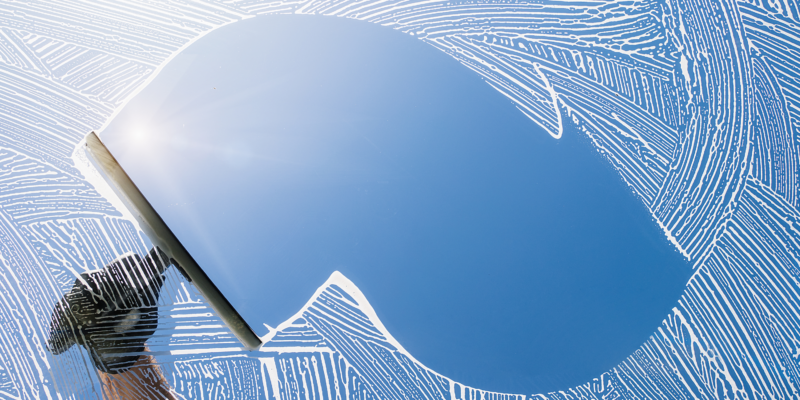A home or building’s attractiveness depends on clean windows. They allow natural light to brighten the interior and improve outside vistas. Clean windows also boost curb appeal, making a property more appealing to purchasers and guests. This article discusses the value of clean windows and offers ways for getting them pristine.
The Importance of Clean Windows: Why You Should Keep Them Spotless
Clean windows have several benefits beyond appearance. Improved natural light is a major benefit. A dark environment results from filthy or streaked windows blocking sunlight. However, clean windows let natural light in, making the area bright and attractive.
Clean windows improve natural light and vistas. You want to fully enjoy your garden or cityscape from your window. Dirty windows might obscure the view and hinder you from enjoying it. Keep your windows clean for a good view of the outside.
Additionally, clean windows improve curb appeal. The cleanliness and condition of your windows is one of the first things potential buyers or visitors notice. Dirty or streaky windows make a place look neglected. However, clean and shining windows can greatly improve the appearance of your home or structure.
Common Causes of Streaks: Understanding Why Your Windows are Always Dirty
Many individuals struggle to clean windows without streaks. Understanding streak causes will help you prevent them and get perfect results. Streaks often result from improper cleaning solutions. Home cleansers may leave residue or contain unsuitable components for window cleaning. You must use a window cleaner developed for this purpose.
Improper window drying after cleaning also causes stains. To avoid streaks, eliminate all moisture while cleaning windows. Using a squeegee or microfiber cloth can prevent streaks. When cleaning windows on a sunny day, the heat might dry the cleaning solution too rapidly, causing streaks.
Choosing the Right Cleaning Solution: What to Look for in a Window Cleaner
Choosing the correct cleaner is essential for clean windows. Each sort of window cleaner has pros and cons. Effectiveness, safety, and environmental impact must be considered while choosing a window cleaner.
Spray-bottle commercial window cleaners are popular. These window cleaners are designed to remove dirt, grime, and streaks. Cleaning agents like ammonia and vinegar are typically in them. You must read the label and follow the instructions to use it safely and effectively.
Alternatives include DIY window cleaning solutions created from household items. One popular spray bottle mixture mixes equal parts water and vinegar. Vinegar is a great natural window cleaner since it cuts grease and grime. Another simple treatment is water with a few drops of dish soap. This solution removes grime and cleans glass well.
The Right Tools for the Job: Essential Equipment for Spotless Windows
Cleaning windows requires the correct tools. The following equipment is essential:
- Squeegee: Essential for window washing. It removes moisture and prevents stains. Look for a rubber-bladed squeegee that glides across glass.
- Microfiber cloths dry and polish windows well. They absorb well and leave no stains. Avoid grime and residue on windows by using a clean microfiber cloth.
- Extension poles: For high windows or hard-to-reach spots, extension poles can save the day. You can clean windows safely without ladders. Look for a strong, height-adjustable extension pole.
The Best Technique for Cleaning Windows: Step-by-Step Instructions for a Perfect Clean
The appropriate approach is needed for clean windows. Step-by-step window cleaning instructions:
- Prepare your supplies: Get your window cleaner, squeegee, microfiber cloths, and extension pole before cleaning.
- Prepare the cleaning solution: Follow the label instructions for a commercial window cleaner. For homemade solutions, mix items in a spray container.
- Spray windows: Spray the cleaning solution evenly across the windows. For thorough cleaning, use enough of solution.
- Remove the cleaning solution vertically with the squeegee from the top corner of the glass. To avoid smears, wipe the squeegee blade with a clean cloth after each stroke.
- Dry and polish glass with a microfiber cloth after squeegeeing. For complete moisture removal, wipe circularly.
- Check windows for streaks and smudges. Buff any using a clean microfiber cloth.
Tips for Cleaning Hard-to-Reach Windows: How to Get Spotless Windows on High Floors
Cleaning high-floor windows is difficult, but with the appropriate methods and tools, you can get perfect results. Tips for cleaning hard-to-reach windows:
- Use an extension pole to reach high windows safely without ladders. Use an extension pole with a squeegee or microfiber cloth to clean windows.
- Buy a window cleaning kit including an extension pole, squeegee, and other tools for high windows. These kits simplify and speed up the process.
- Consider hiring a professional window cleaning service if you have numerous high windows or find it difficult to clean them. They carefully clean hard-to-reach windows with their skill and equipment.
How to Clean Windows in Different Weather Conditions: Tips for Cleaning Windows in the Rain, Snow, or Sun
Cleaning windows in different weather requires adaptations for perfect results. Tips for cleaning windows in different weather:
- Cleaning windows in the rain: It may seem paradoxical, but it works. Clean rainwater may wash away filth and grime. However, cleaning windows in heavy rain or during a storm can be difficult and dangerous.
- Snowy windows: The cleaning solution might freeze fast, making window washing difficult. Consider cleaning the windows from the inside or waiting for a milder day. Use a freeze-safe solution and work fast to avoid freezing the solution on the glass when cleaning windows in the snow.
- Cleaning windows in direct sunlight: The heat can dry the cleaning solution too rapidly, causing stains. Choose an overcast day or clean windows early in the morning or late in the afternoon when the sun is less powerful to avoid streaks. When cleaning windows in the sun, work in tiny portions and wipe away the cleaning solution before it dries.
How Often Should You Clean Your Windows? A Guide to Keeping Your Windows Clean All Year Round
Location, weather, and personal preference determine window cleaning frequency. Aim to clean your windows twice a year, preferably in spring and fall. These seasons are perfect for cleaning out winter and summer filth.
If you live near construction sites or polluted areas, you may need to clean your windows more often. Cleaning regularly is also important in coastal areas where saltwater can cause corrosion.
You decide how often to clean your windows based on your situation. Regular maintenance and washing will keep your windows clean year-round.
DIY Window Cleaning: Homemade Solutions for Spotless Windows
These homemade window cleaner recipes employ ordinary household ingredients:
- Vinegar solution: Mix water and vinegar equally in a spray container. Scrub the windows with a squeegee or microfiber cloth after spraying the solution. Vinegar cleans grease and dirt well.
- Dish soap solution: Mix a few drops of dish soap with water in a spray bottle. Wash and dry windows with a squeegee or microfiber towel after spraying the solution. Cleaning windows with dish soap removes grime and shines.
- Spray bottle lemon juice solution: Mix equal parts lemon juice and water. Wash and dry windows with a squeegee or microfiber towel after spraying the solution. Lemon juice naturally removes stains and filth.
Troubleshooting Common Window Cleaning Problems: How to Fix Streaks, Smudges, and Other Issues
Even with the correct methods and tools, window cleaning issues can arise. Some frequent concerns and solutions:
- Streaks: If the cleaning solution isn’t adequately removed or the windows aren’t dried, streaks can emerge. Reapply the cleaning solution and squeegee to erase streaks or buff them with a clean microfiber cloth.
- Smudges: Fingerprints and cleaning product residue generate smudges. Smudges can be carefully removed with a clean microfiber cloth soaked with water or a mild cleaning solution.
- Water spots: Hard water or improper window drying can cause water marks. Pour equal parts water and vinegar into a spray bottle and apply to water spots. Leave it for a few minutes, then wipe it with a clean microfiber cloth.
- Stubborn stains: Deeper cleaning may be needed. Make a paste of baking soda and water and apply to discolored areas. Wait a few minutes, then cleanse gently with a soft brush or sponge. Wash and dry.
Conclusion
A home or building’s attractiveness depends on clean windows. They enhance natural light, views, and curb appeal. Spotless windows can be achieved by identifying streak reasons, using a suitable cleaning solution and instruments, and following the proper technique.
Tips and strategies might help you clean windows on high floors or in varied weather situations. Windows will stay clean year-round with regular maintenance and cleaning.
So why delay? Clean your windows now to enjoy sparkling windows in your house or building.


